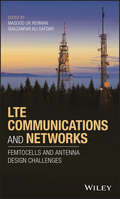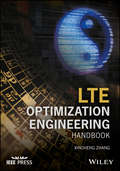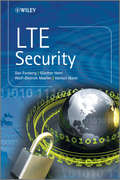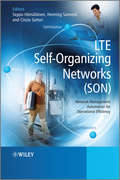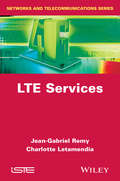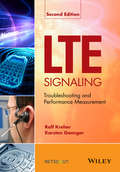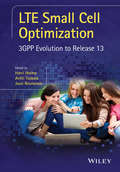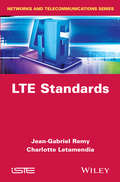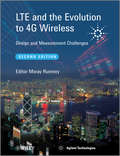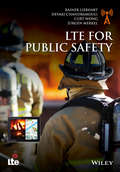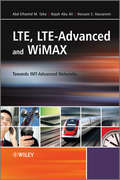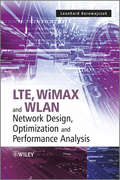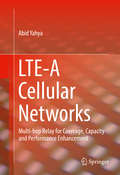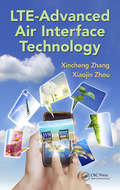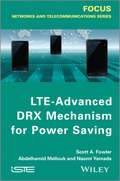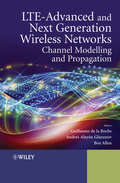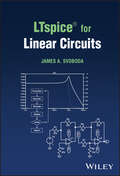- Table View
- List View
LTE Communications and Networks: Femtocells and Antenna Design Challenges
by Masood Ur Rehman Ghazanfar Ali SafdarA comprehensive resource to the latest developments of system enhancement techniques of Femtocells, power management, interference mitigation and antenna design LTE Communications and Networks fills a gap in the literature to offer a comprehensive review of the most current developments of LTE Femtocells and antennas and explores their future growth. With contributions from a group of experts that represent the fields of wireless communications and mobile communications, signal processing and antenna design, this text identifies technical challenges and presents recent results related to the development, integration and enhancement of LTE systems in portable devices. The authors examine topics such as application of cognitive radio with efficient sensing mechanisms, interference mitigation and power management schemes for the LTE systems. They also provide a comprehensive account of design challenges and approaches, performance enhancement techniques and effects of user’s presence on the LTE antennas. LTE Communications and Networks also highlights the promising technologies of multiband, multimode and reconfigurable antennas for efficient design of portable LTE devices. Designed to be a practical resource, this text: Explores the interference mitigation, power control and spectrum management in LTE Femtocells and related issues Contains information on the design challenges, different approaches, performance enhancement and application case scenarios for the LTE antennas Covers the most recent developments of system enhancement techniques in terms of Femtocells, power management, interference mitigation and antenna design Includes contributions from leading experts in the field Written for industry professionals and researchers, LTE Communications and Networks is a groundbreaking book that presents a comprehensive treatment to the LTE systems in the context of Femtocells and antenna design and covers the wide range of issues related to the topic.
LTE Optimization Engineering Handbook
by Xincheng ZhangA comprehensive resource containing the operating principles and key insights of LTE networks performance optimization LTE Optimization Engineering Handbook is a comprehensive reference that describes the most current technologies and optimization principles for LTE networks. The text offers an introduction to the basics of LTE architecture, services and technologies and includes details on the key principles and methods of LTE optimization and its parameters. In addition, the author clarifies different optimization aspects such as wireless channel optimization, data optimization, CSFB, VoLTE, and video optimization. With the ubiquitous usage and increased development of mobile networks and smart devices, LTE is the 4G network that will be the only mainstream technology in the current mobile communication system and in the near future. Designed for use by researchers, engineers and operators working in the field of mobile communications and written by a noted engineer and experienced researcher, the LTE Optimization Engineering Handbook provides an essential guide that: Discusses the latest optimization engineering technologies of LTE networks and explores their implementation Features the latest and most industrially relevant applications, such as VoLTE and HetNets Includes a wealth of detailed scenarios and optimization real-world case studies Professionals in the field will find the LTE Optimization Engineering Handbook to be their go-to reference that includes a thorough and complete examination of LTE networks, their operating principles, and the most current information to performance optimization.
LTE Security
by Wolf-Dietrich Moeller Dan Forsberg Valtteri Niemi Günther HornA concise, updated guide to the 3GPP LTE Security Standardization specificationsA welcome Revised Edition of the successful LTE Security addressing the security architecture for SAE/LTE, which is based on elements of the security architectures for GSM and 3G, but which needed a major redesign due to the significantly increased complexity, and different architectural and business requirements of fourth generation systems. The authors explain in detail the security mechanisms employed to meet these requirements. The specifications generated by standardization bodies only inform about how to implement the system (and this only to the extent required for interoperability), but almost never inform readers about why things are done the way they are. Furthermore, specifications tend to be readable only for a small group of experts and lack the context of the broader picture. The book fills this gap by providing first hand information from insiders who participated in decisively shaping SAE/LTE security in the relevant standardization body, 3GPP, and can therefore explain the rationale for design decisions in this area.A concise, fully updated guide to the 3GPP LTE Security Standardization specificationsDescribes the essential elements of LTE and SAE Security, written by leading experts who participated in decisively shaping SAE/LTE security in the relevant standardization body, 3GPPExplains the rationale behind the standards specifications giving readers a broader understanding of the context to these specificationsIncludes new chapters covering 3GPP work on system enhancements for MTC, plus application layer security in ETSI TC M2M and embedded smart card in ETSI SCP; Security for Machine-type Communication, Relay Node Security, and Future Challenges, including Voice over LTE, MTC, Home base stations, LIPA/SIPTO, and New Cryptographic AlgorithmsEssential reading for System engineers, developers and people in technical sales working in the area of LTE and LTE security, communication engineers and software developers in mobile communication field.
LTE Security (NSN/Nokia Series #1)
by Wolf-Dietrich Moeller Dan Forsberg Valtteri Niemi Günther HornA concise, updated guide to the 3GPP LTE Security Standardization specifications A welcome Revised Edition of the successful LTE Security addressing the security architecture for SAE/LTE, which is based on elements of the security architectures for GSM and 3G, but which needed a major redesign due to the significantly increased complexity, and different architectural and business requirements of fourth generation systems. The authors explain in detail the security mechanisms employed to meet these requirements. The specifications generated by standardization bodies only inform about how to implement the system (and this only to the extent required for interoperability), but almost never inform readers about why things are done the way they are. Furthermore, specifications tend to be readable only for a small group of experts and lack the context of the broader picture. The book fills this gap by providing first hand information from insiders who participated in decisively shaping SAE/LTE security in the relevant standardization body, 3GPP, and can therefore explain the rationale for design decisions in this area. A concise, fully updated guide to the 3GPP LTE Security Standardization specifications Describes the essential elements of LTE and SAE Security, written by leading experts who participated in decisively shaping SAE/LTE security in the relevant standardization body, 3GPP Explains the rationale behind the standards specifications giving readers a broader understanding of the context to these specifications Includes new chapters covering 3GPP work on system enhancements for MTC, plus application layer security in ETSI TC M2M and embedded smart card in ETSI SCP; Security for Machine-type Communication, Relay Node Security, and Future Challenges, including Voice over LTE, MTC, Home base stations, LIPA/SIPTO, and New Cryptographic Algorithms Essential reading for System engineers, developers and people in technical sales working in the area of LTE and LTE security, communication engineers and software developers in mobile communication field.
LTE Security (Nsn/nokia Ser. #1)
by Wolf-Dietrich Moeller Dan Forsberg Valtteri Niemi Günther HornAddressing the security solutions for LTE, a cellular technology from Third Generation Partnership Project (3GPP), this book shows how LTE security substantially extends GSM and 3G security. It also encompasses the architectural aspects, known as SAE, to give a comprehensive resource on the topic. Although the security for SAE/LTE evolved from the security for GSM and 3G, due to different architectural and business requirements of fourth generation systems the SAE/LTE security architecture is substantially different from its predecessors. This book presents in detail the security mechanisms employed to meet these requirements. Whilst the industry standards inform how to implement systems, they do not provide readers with the underlying principles behind security specifications. LTE Security fills this gap by providing first hand information from 3GPP insiders who explain the rationale for design decisions. Key features: Provides a concise guide to the 3GPP/LTE Security Standardization specifications Authors are leading experts who participated in decisively shaping SAE/LTE security in the relevant standardization body, 3GPP Shows how GSM and 3G security was enhanced and extended to meet the requirements of fourth generation systems Gives the rationale behind the standards specifications enabling readers to have a broader understanding of the context of these specifications Explains why LTE security solutions are designed as they are and how theoretical security mechanisms can be put to practical use
LTE Self-Organising Networks (SON)
by Seppo Hämäläinen Cinzia Sartori Henning SanneckCovering the key functional areas of LTE Self-Organising Networks (SON), this book introduces the topic at an advanced level before examining the state-of-the-art concepts. The required background on LTE network scenarios, technologies and general SON concepts is first given to allow readers with basic knowledge of mobile networks to understand the detailed discussion of key SON functional areas (self-configuration, -optimisation, -healing). Later, the book provides details and references for advanced readers familiar with LTE and SON, including the latest status of 3GPP standardisation.Based on the defined next generation mobile networks (NGMN) and 3GPP SON use cases, the book elaborates to give the full picture of a SON-enabled system including its enabling technologies, architecture and operation. "Heterogeneous networks" including different cell hierarchy levels and multiple radio access technologies as a new driver for SON are also discussed.Introduces the functional areas of LTE SON (self-optimisation, -configuration and -healing) and its standardisation, also giving NGMN and 3GPP use casesExplains the drivers, requirements, challenges, enabling technologies and architectures for a SON-enabled systemCovers multi-technology (2G/3G) aspects as well as core network and end-to-end operational aspectsWritten by experts who have been contributing to the development and standardisation of the LTE self-organising networks concept since its inceptionExamines the impact of new network architectures ("Heterogeneous Networks") to network operation, for example multiple cell layers and radio access technologies
LTE Services
by Jean-Gabriel Rémy Charlotte LetamendiaLTE (Long Term Evolution) is commonly marketed as 4G. LTE and LTE Advanced have been recognized by ITU-R and ITU-T (International Telecommunications Union - Telecommunications) as the principal solution for the future mobile communication networks standards. They are thus the framework of what the marketing calls 4G and possibly also 5G.This book describes various aspects of LTE as well as the change of paradigm, which it is bringing to mobile communications, focusing on LTE standards and architecture, OFDMA, the Full IP Core Network and LTE security.
LTE Signaling
by Karsten Gaenger Ralf KreherA comprehensive reference on the call procedures of 4G RAN and Core networks, LTE Signaling, Troubleshooting and Optimization describes the protocols and procedures of LTE. It explains essential topics from basic performance measurement counters, radio quality and user plane quality to the standards, architecture, objectives and functions of the different interfaces. The first section gives an overview of LTE/EPC network architecture, reference points, protocol stacks, information elements and elementary procedures. The proceeding parts target more advanced topics to cover LTE/EPC signalling and radio quality analysis.This book supplements the information provided in the 3GPP standards by giving readers access to a universal LTE/EPC protocol sequence to ensure they have a clear understanding of the issues involved. It describes the normal signaling procedures as well as explaining how to identify and troubleshoot abnormal network behavior and common failure causes.Enables the reader to understand the signaling procedures and parameters that need to be analyzed when monitoring UMTS networksCovers the essential facts on signaling procedures by providing first hand information taken from real LTE/EPC tracesA useful reference on the topic, also providing sufficient details for test and measurement experts who need to analyze LTE/EPC signaling procedures and measurements at the most detailed levelContains a description of LTE air interface monitoring scenarios as well as other key topics up to an advanced levelLTE Signaling, Troubleshooting and Optimization is the Long Term Evolution successor to the previous Wiley books UMTS Signaling and UMTS Performance Measurement.
LTE Signaling: Troubleshooting and Optimization
by Karsten Gaenger Ralf KreherA comprehensive reference on the call procedures of 4G RAN and Core networks, LTE Signaling, Troubleshooting and Optimization describes the protocols and procedures of LTE. It explains essential topics from basic performance measurement counters, radio quality and user plane quality to the standards, architecture, objectives and functions of the different interfaces. The first section gives an overview of LTE/EPC network architecture, reference points, protocol stacks, information elements and elementary procedures. The proceeding parts target more advanced topics to cover LTE/EPC signalling and radio quality analysis. This book supplements the information provided in the 3GPP standards by giving readers access to a universal LTE/EPC protocol sequence to ensure they have a clear understanding of the issues involved. It describes the normal signaling procedures as well as explaining how to identify and troubleshoot abnormal network behavior and common failure causes. Enables the reader to understand the signaling procedures and parameters that need to be analyzed when monitoring UMTS networks Covers the essential facts on signaling procedures by providing first hand information taken from real LTE/EPC traces A useful reference on the topic, also providing sufficient details for test and measurement experts who need to analyze LTE/EPC signaling procedures and measurements at the most detailed level Contains a description of LTE air interface monitoring scenarios as well as other key topics up to an advanced level LTE Signaling, Troubleshooting and Optimization is the Long Term Evolution successor to the previous Wiley books UMTS Signaling and UMTS Performance Measurement.
LTE Small Cell Optimization
by Antti Toskala Harri Holma Jussi ReunanenThis book addresses R&D and standardization activities on LTE small cells and network optimization, focusing on 3GPP evolution to Release 13. In addition, the book is written by experts from Renesas, T-Mobile, Teliasonera and Videotron. The book covers: 1) LTE small cells from specification to products and field results, 2) Latest 3GPP evolution to Release 13 and 3) LTE optimization and learnings from the field.
LTE Standards
by Jean-Gabriel Rémy Charlotte LetamendiaLTE (long-term evolution) mobile communication system is offering high bitrates in IP communications. Fourth Generation Mobile Communications/LTE describes various aspects of LTE as well as the change of paradigm, which it is bringing to mobile communications. The book is a vital resource for the entire mobile communication community. Coverage includes: LTE standards and architecture, Radio access sub-system, Signaling on the radio path, Macrocells, microcells, femtocells, SIM card and security, SIM card description, GPS driven applications, The Apple model, and much more more.
LTE and the Evolution to 4G Wireless
by Moray Rumney Agilent TechnologiesA practical guide to LTE design, test and measurement, this new edition has been updated to include the latest developmentsThis book presents the latest details on LTE from a practical and technical perspective. Written by Agilent's measurement experts, it offers a valuable insight into LTE technology and its design and test challenges. Chapters cover the upper layer signaling and system architecture evolution (SAE). Basic concepts such as MIMO and SC-FDMA, the new uplink modulation scheme, are introduced and explained, and the authors look into the challenges of verifying the designs of the receivers, transmitters and protocols of LTE systems. The latest information on RF and signaling conformance testing is delivered by authors participating in the LTE 3GPP standards committees.This second edition has been considerably revised to reflect the most recent developments of the technologies and standards. Particularly important updates include an increased focus on LTE-Advanced as well as the latest testing specifications.Fully updated to include the latest information on LTE 3GPP standardsChapters on conformance testing have been majorly revised and there is an increased focus on LTE-AdvancedIncludes new sections on testing challenges as well as over the air MIMO testing, protocol testing and the most up-to-date test capabilities of instrumentsWritten from both a technical and practical point of view by leading experts in the field
LTE for 4G Mobile Broadband
by Farooq KhanDo you need to get up to speed quickly on LTE? Understand the new technologies of the LTE standard and how they contribute to improvements in system performance with this practical and valuable guide, written by an expert on LTE who was intimately involved in drafting the standard. In addition to a strong grounding in the technical details, you'll also get fascinating insights into why particular technologies were chosen in the development process. Core topics covered include low-PAPR orthogonal uplink multiple access based on SC-FDMA, MIMO multi-antenna technologies, and inter-cell interference mitigation techniques. Low-latency channel structure and single-frequency network (SFN) broadcast are also discussed in detail. With extensive references, a useful discussion of technologies that were not included in the standard, and end-of-chapter summaries that emphasize all the key points, this book is an essential resource for practitioners in the mobile cellular communications industry and for graduate students studying advanced wireless communications.
LTE for Public Safety
by Rainer Liebhart Devaki Chandramouli Curt Wong Jürgen MerkelThe aim of the book is to educate government agencies, operators, vendors and other regulatory institutions how LTE can be deployed to serve public safety market and offer regulatory / public safety features. It is written in such a way that it can be understood by both technical and non-technical personnel with just introductory knowledge in wireless communication. Some sections and chapters about public safety services offered by LTE network are intended to be understood by anyone with no knowledge in wireless communication.ulatory requirements for public safety networks. These include features such as group call communication (one talker and several listeners) and proximity services (i.e. looking for other devices in near proximity and establishing connections to them without network coverage). In addition, it provides an in-depth analysis on how LTE is being used by the emergency responders as their own dedicated mission critical network and the specialized features that are needed in LTE for providing robust and mission critical communications amongst first responders.The aim of the book is to educate government agencies, operators, vendors and other regulatory institutions how LTE can be deployed to serve public safety market and offer regulatory / public safety features. It is written in such a way that it can be understood by both technical and non-technical personnel with just introductory knowledge in wireless communication. Some sections and chapters about public safety services offered by LTE network are intended to be understood by anyone with no knowledge in wireless communication.
LTE for UMTS
by Antti Toskala Harri HolmaWritten by experts actively involved in the 3GPP standards and product development, LTE for UMTS, Second Edition gives a complete and up-to-date overview of Long Term Evolution (LTE) in a systematic and clear manner. Building upon on the success of the first edition, LTE for UMTS, Second Edition has been revised to now contain improved coverage of the Release 8 LTE details, including field performance results, transport network, self optimized networks and also covering the enhancements done in 3GPP Release 9. This new edition also provides an outlook to Release 10, including the overview of Release 10 LTE-Advanced technology components which enable reaching data rates beyond 1 Gbps.Key updates for the second edition of LTE for UMTS are focused on the new topics from Release 9 & 10, and include:LTE-Advanced;Self optimized networks (SON);Transport network dimensioning;Measurement results.
LTE, LTE-Advanced and WiMAX
by Hossam S. Hassanein Abd-Elhamid M. Taha Najah Abu AliA concise introduction to IMT-Advanced Systems, including LTE-Advanced and WiMAXThere exists a strong demand for fully extending emerging Internet services, including collaborative applications and social networking, to the mobile and wireless domain. Delivering such services can be possible only through realizing broadband in the wireless. Two candidate technologies are currently competing in fulfilling the requirements for wireless broadband networks, WiMAX and LTE. At the moment, LTE and its future evolution LTE-Advanced are already gaining ground in terms of vendor and operator support. Whilst both technologies share certain attributes (utilizing Orthogonal Frequency Division Multiple Access (OFDMA) in downlink, accommodating smart antennas and full support for IP-switching, for example), they differ in others (including uplink technology, scheduling, frame structure and mobility support). Beyond technological merits, factors such as deployment readiness, ecosystem maturity and migration feasibility come to light when comparing the aptitude of the two technologies.LTE, LTE-Advanced and WiMAX: Towards IMT-Advanced Networks provides a concise, no-nonsense introduction to the two technologies, covering both interface and networking considerations. More critically, the book gives a multi-faceted comparison, carefully analyzing and distinguishing the characteristics of each technology and spanning both technical and economic merits. A "big picture" understanding of the market strategies and forecasts is also offered.Discusses and critically evaluates LTE, LTE-Advanced and WiMAX (Legacy and Advanced)Gives an overview of the principles and advances of each enabling technologyOffers a feature-by-feature comparison between the candidate technologiesIncludes information which appeals to both industry practitioners and academicsProvides an up-to-date report on market and industry status
LTE, WiMAX and WLAN Network Design, Optimization and Performance Analysis
by Leonhard KorowajczukA technological overview of LTE and WiMAX LTE, WiMAX and WLAN Network Design, Optimization and Performance Analysis provides a practical guide to LTE and WiMAX technologies introducing various tools and concepts used within. In addition, topics such as traffic modelling of IP-centric networks, RF propagation, fading, mobility, and indoor coverage are explored; new techniques which increase throughput such as MIMO and AAS technology are highlighted; and simulation, network design and performance analysis are also examined. Finally, in the latter part of the book Korowajczuk gives a step-by-step guide to network design, providing readers with the capability to build reliable and robust data networks. By focusing on LTE and WiMAX this book extends current network planning approaches to next generation wireless systems based on OFDMA, providing an essential resource for engineers and operators of fixed and wireless broadband data access networks. With information presented in a sequential format, LTE, WiMAX and WLAN Network Design, Optimization and Performance Analysis aids a progressive development of knowledge, complementing latter graduate and postgraduate courses while also providing a valuable resource to network designers, equipment vendors, reference material, operators, consultants, and regulators. Key Features: One of the first books to comprehensively explain and evaluate LTE Provides an unique explanation of the basic concepts involved in wireless broadband technologies and their applications in LTE, WiMAX, and WLAN before progressing to the network design Demonstrates the application of network planning for LTE and WiMAX with theoretical and practical approaches Includes all aspects of system design and optimization, such as dynamic traffic simulations, multi-layered traffic analysis, statistical interference analysis, and performance estimations
LTE-A Cellular Networks
by Abid YahyaIn this book, three different methods are presented to enhance the capacity and coverage area in LTE-A cellular networks. The scope involves the evaluation of the effect of the RN location in terms of capacity and the determination of the optimum location of the relay that provides maximum achievable data rate for users with limited interference at the cell boundaries. This book presents a new model to enhance both capacity and coverage area in LTE-A cellular network by determining the optimum location for the RN with limited interference. A new model is designed to enhance the capacity of the relay link by employing two antennas in RN. This design enables the relay link to absorb more users at cell edge regions. An algorithm called the Balance Power Algorithm (BPA) is developed to reduce MR power consumption. The book pertains to postgraduate students and researchers in wireless & mobile communications.
LTE-Advanced Air Interface Technology
by Xincheng Zhang Xiaojin ZhouOpportunities are at hand for professionals eager to learn and apply the latest theories and practices in air interface technologies. Written by experienced researchers and professionals, LTE-Advanced Air Interface Technology thoroughly covers the performance targets and technology components studied by 3GPP for LTE-Advanced. Besides being an expla
LTE-Advanced DRX Mechanism for Power Saving
by Abdelhamid Mellouk Scott A. Fowler Naomi YamadaResource allocation and power optimization is a new challenge in multimedia services in cellular communication systems. To provide a better end-user experience, the fourth generation (4G) standard Long Term Evolution/Long Term Evolution-Advanced (LTE/LTE-Advanced) has been developed for high-bandwidth mobile access to accommodate today’s data-heavy applications. LTE/LTE-Advanced has adopted discontinuous reception (DRX) to extend the user equipment’s battery lifetime, thereby further supporting various services and large amounts of data transmissions. By introducing the basics of mathematical analysis and performance evaluation of power-saving mechanisms in 3rd generation partnership project (3GPP) LTE and LTE-Advanced networks, the authors of this book aim to describe novel algorithms which could have better performance capabilities than previous methods. Chapter 1 gives the basic theory description of the 3GPP LTE network and 3GPP DRX power saving mechanism, empirical measurements of LTE network traffic and an overview of the basic LTE DRX model in the field of power saving techniques. Chapter 2 provides steps for deriving a 2-state analytical model up to a 4-state DRX model. The third and final chapter summarizes alternative methods for the implementation of LTE DRX. Contents 1. Basic Theory. 2. Analytical Semi-Markov Power-Saving Models. 3. Other Approaches for LTE Power Saving. About the Authors Scott A. Fowler is Associate Professor at Linköping University, Sweden, working with the Mobile Telecommunication (MT) group. He has served on several IEEE conferences/workshops as TPC to Chair, including Special Interest Groups coordinator for IEEE Communications Software (CommSoft) Technical Committee since 2012. His research interests include Quality of Service (QoS) support over heterogeneous networks, computer networks (wired, wireless), energy management, mobile computing, pervasive/ubiquitous, performance evaluation of networks and security. Abdelhamid Mellouk is Full Professor at the University of Paris-Est Créteil VdM (UPEC, ex. Paris 12), Networks & Telecommunications (N&T) Department (IUT C/V) and LiSSi Laboratory in France. He is a founder of the Network Control Research activity with extensive international academic and industrial collaborations. His general area of research is in adaptive real-time control for high-speed new generation dynamic wired/wireless networking in order to maintain acceptable Quality of Service/Experience for added-value services. Naomi Yamada is a research associate at Linköping University, Sweden.
LTE-Advanced Relay Technology and Standardization
by Yifei YuanLTE-Advanced relay technology and standardization provides a timely reference work for relay technology with the finalizing of LTE Release 10 specifications. LTE-Advanced is quickly becoming the global standard for 4G cellular communications. The relay technology, as one of the key features in LTE-Advanced, helps not only to improve the system coverage and capacity, but also to save the costs of laying wireline backhaul. As a leading researcher in the field of LTE-Advanced standards, the author provides an in-depth description of LTE-A relay technology, and explains in detail the standard specification and design principles. Readers from both academic and industrial fields can find sections of interest to them: Sections 2 & 4 could benefit researchers in academia and those who are engaged in exploratory work, while Sections 3 & 4 are more useful to engineers. Dr. Yifei Yuan is the Technical Director at the Standards Department of ZTE Inc.
LTE-Advanced and Next Generation Wireless Networks
by Guillaume De La Roche Andres Alayon-Glazunov Ben AllenLTE- A and Next Generation Wireless Networks: Channel Modeling and Performance describes recent advances in propagation and channel modeling necessary for simulating next generation wireless systems. Due to the radio spectrum scarcity, two fundamental changes are anticipated compared to the current status. Firstly, the strict reservation of a specific band for a unique standard could evolve toward a priority policy allowing the co-existence of secondary users in a band allocated to a primary system. Secondly, a huge increase of the number of cells is expected by combining outdoor base stations with smaller cells such as pico/femto cells and relays. This evolution is accompanied with the emergence of cognitive radio that becomes a reality in terminals together with the development of self-organization capabilities and distributed cooperative behaviors. The book is divided into three parts: Part I addresses the fundamentals (e. g. technologies, channel modeling principles etc. ) Part II addresses propagation and modeling discussing topics such as indoor propagation, outdoor propagation, etc. Part III explores system performance and applications (e. g. MIMO Over-the-air testing, electromagnetic safety, etc).
LTspice® for Linear Circuits
by James A. SvobodaLTspice® for Linear Circuits Introduce yourself to the industry-leading software in electronic circuit simulation The simulation of electronic circuits is a crucial tool in modern electrical engineering. Many currently available software toolkits for circuit simulation are expensive, or nominally free but with significant restrictions on features and applications. LTspice®, a software distributed by semiconductor manufacturer Analog Devices, is not only the most widely used SPICE-based circuit simulator in the industry, but also free and unrestricted. LTspice®for Linear Circuits provides a comprehensive introduction to this software and its circuit simulation capabilities. Focusing on the fostering of practical knowledge, the book develops a six-step strategy for solving circuit analysis problems, beginning with the formulation of the problem, and proceeding through the simulation and the review of results. Readable and built around an easy-to-use, accessible software, LTspice® for Linear Circuits is an essential tool for any would-be electrical engineer. LTspice® for Linear Circuits readers will also find: Practical examples of circuit analysis problems and their solutions Detailed treatment of problems involving DC Circuits, First-Order Circuits, AC Circuits, Frequency Response and more Educational content from an author with decades of experience teaching electrical circuits LTspice®for Linear Circuits is perfect for undergraduates in electrical engineering and adjacent subjects, as well as anyone looking for an introduction to this widely used software.
La Banda de los Tryzubs
by John Reinhard DizonDespués de que los investigadores rusos desarrollaron una milagrosa curación para el VIH, la Corporación Trident empieza las pruebas beta de la droga en los Estados Unidos. Sabrina se enreda en una red internacional de intriga, mientras los terroristas están usando el proyecto como cobertura para atacar en suelo americano. Enseguida, un ataque terrorista sacude a Wall Street. Es hora de que el Merodeador Nocturno entre en acción nuevamente. Pero esta vez, el amor de Sabrina Hoyt está en el centro de la acción. Con la guerra entre los carteles de la droga destruyendo todo a su alrededor, podrá Sabrina llevar a los criminales a la justicia--y proteger a su prometido.
La Cepa Enigma
by Nick Thacker Nicolás FlórezUn thriller de biotecnología, creado por el autor de bestsellers en materia de thrillers de acción/aventure y ciencia ficción, La Cepa Enigma es el primer en la serie de Harvey Bennett. Cuando estalla una bomba en el Parque Nacional de Yellowstone, amenazando la estabilidad del volcán activo más grande del mundo, el reclusivo guardabosques Harvey "Ben" Bennett se sorprende al descubrir que la explosión misma no era la única amenaza: la bomba liberó algún tipo de virus al aire, y comenzaba a infectar y matar más y más personas. Ben hace equipo con Juliette Richardson, una tenaz agente del CCE que trabaja en el recien formado equipo IAB (Investigación de Amenazas Biológicas), para hallar a la gente detrás de este acto de terrorismo. Cuando los ataques se vuelven personales, Ben y Julie se deben encargar de buscar y destruir la amenaza antes de que sea demasiado tarde. Una carrera a través de los Estados Unidos, persiguiendo terroristas, esquivando balas, y escapando de la amenaza de un brote mortal de un virus...
